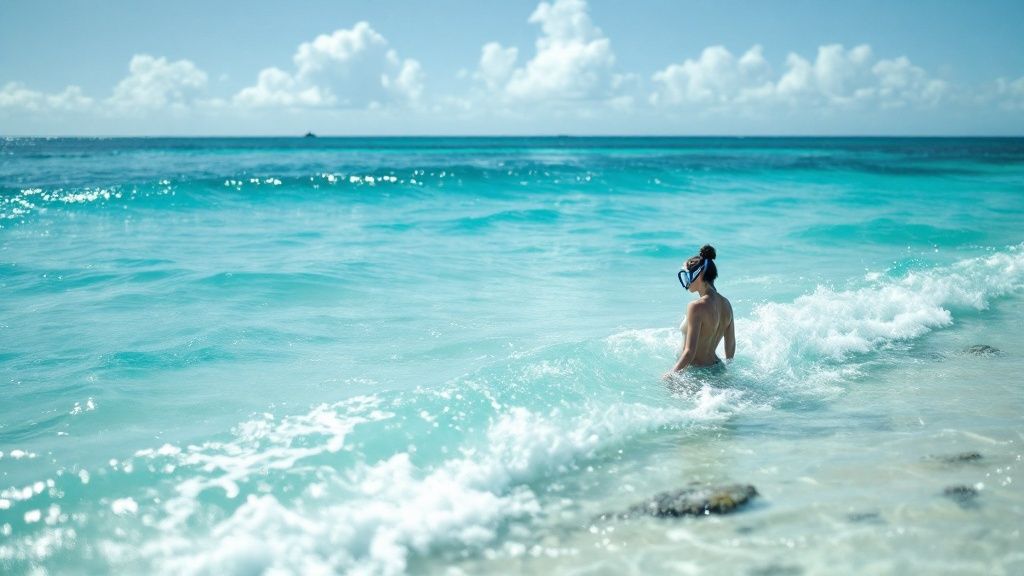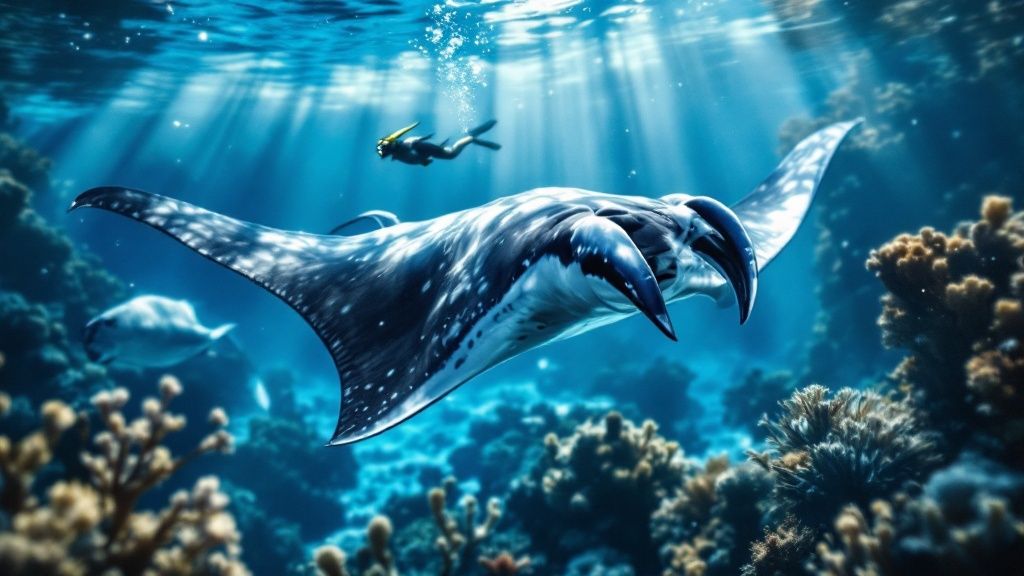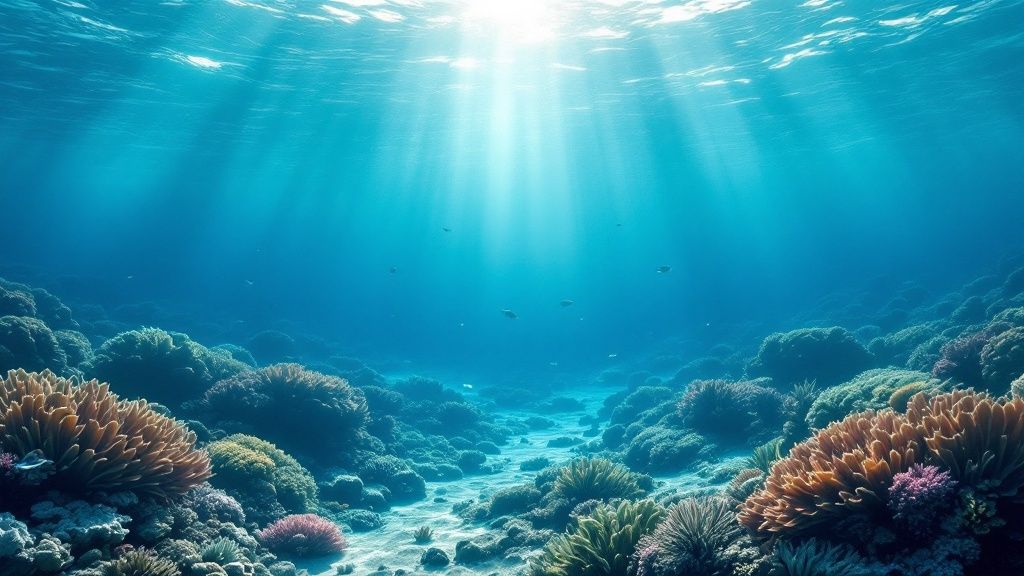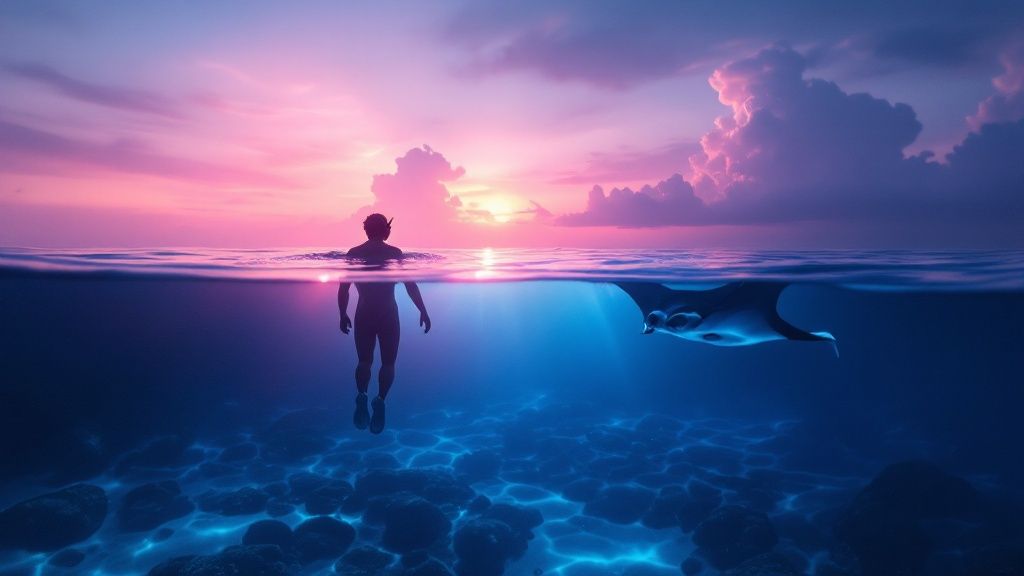Prime Spots: Where Manta Magic Happens on Big Island

The Big Island of Hawaii is a renowned destination for snorkeling enthusiasts, especially those eager to encounter manta rays. While the island offers numerous snorkeling spots, some locations consistently provide more breathtaking encounters than others. These aren't just random spots; they're chosen strategically based on the behaviors and needs of these gentle giants. Let's delve into two of the most famous locations and discover why they are so attractive to manta rays.
Keauhou Bay: A Manta Ray Haven
Keauhou Bay, affectionately nicknamed Manta Ray Village, is legendary for its frequent manta ray sightings. The bay's shallow depth and generally calm waters create an ideal setting for night snorkeling. The sandy bottom and nearby coral reefs provide ample space for the mantas to perform their captivating feeding rituals.
Keauhou Bay's rich plankton population, the manta rays' primary food source, is a major draw. The lights from tour boats attract plankton to the surface, creating a spectacular feeding frenzy that draws in these majestic creatures.
Kona Coast: Garden Eel Cove and Hidden Gems
Along the Kona Coast, Garden Eel Cove is another prime location for observing manta rays. Like Keauhou Bay, this area boasts abundant plankton. However, the consistent currents are the real highlight here, bringing a continuous flow of plankton and concentrating the mantas in predictable locations.
Beyond Garden Eel Cove, experienced local guides often know secret spots along the Kona Coast that offer exceptional, less-crowded viewing opportunities. These hidden gems can provide a more intimate and personalized experience with the mantas.
Comparing the Top Spots
To help you decide which location best suits your snorkeling adventure, take a look at this comparison table:
Top Manta Ray Snorkeling Locations Compared: Comparison of primary manta ray snorkeling locations on Big Island
Location | Best Time | Accessibility | Average Sightings | Water Conditions |
|---|---|---|---|---|
Keauhou Bay | Year-round | Easy | High | Calm |
Kona Coast | Summer | Moderate | High | Can be choppy |
This table highlights the key differences and similarities between Keauhou Bay and the Kona Coast for manta ray snorkeling. Keauhou Bay offers year-round viewing with easy access and calm waters, while the Kona Coast excels during the summer months, offering potentially higher sightings but with more challenging water conditions.
Choosing the perfect spot depends on your experience level and personal preferences. For more detailed insights into past snorkeling experiences and conditions, explore Our Blog Post Sitemap. Kona Coast experiences, for example, are typically more susceptible to changing weather patterns than the sheltered Keauhou Bay. While Kona Coast can offer incredible sightings under optimal conditions, Keauhou Bay provides a more reliable experience, particularly during the winter months. The plentiful plankton in both locations contributes to the high number of manta ray sightings, making snorkeling with these magnificent creatures on the Big Island an unforgettable experience.
Perfect Timing: When to Experience Manta Magic
The difference between an average snorkeling trip and a truly unforgettable manta ray encounter often comes down to timing. Understanding the connection between moon phases, seasonal changes, and manta ray feeding habits is key to planning an amazing experience. We've spoken with experienced manta ray guides to uncover the secrets behind consistently spectacular sightings.
Decoding the Moon's Influence
The moon plays a crucial role in how manta rays feed. The lunar cycle influences the tides, which in turn affect the movement of zooplankton, the manta ray's main food source. During a new moon, the lack of moonlight draws plankton towards the lights used by tour operators. This creates a perfect feeding opportunity for the mantas, increasing your chances of an incredible close encounter. A full moon, however, can scatter the plankton, making manta ray activity harder to predict.
Seasonal Variations and Manta Behavior
Manta rays can be spotted year-round off the Big Island, but certain seasons offer better viewing conditions. The summer months, from May to September, typically have calmer waters and higher plankton concentrations. Keep in mind that these are also the busiest months for tourism, so tours might be more crowded. For more detailed planning information, check out Our Sitemap. Winter months can bring rougher seas, potentially affecting visibility and tour availability.
Day vs. Night: Unveiling the Magic of Night Snorkeling
While you can see manta rays during the day, the Big Island's famous night snorkeling tours provide a truly special experience. Manta rays are filter feeders, consuming massive amounts of zooplankton, which are drawn to the lights used on these tours. This creates an ideal setting for observing these gentle giants, some of which have wingspans reaching up to 20 feet. For more fascinating facts about manta rays, visit Manta Ray Advocates.
Optimizing Your Manta Ray Encounter
To increase your chances of a magical manta ray experience, consider these tips:
Book during a new moon: The darkness intensifies the plankton's attraction to the tour lights, boosting manta ray activity.
Consider shoulder seasons: April-May and September-October offer a pleasant balance of good weather and fewer crowds.
Choose a reputable tour operator: Experienced guides understand manta ray behavior and promote responsible viewing practices.
Be flexible: Weather in Hawaii can be unpredictable, so be ready to adjust your plans as needed.
By considering these factors and planning strategically, you'll greatly improve your chances of a truly unforgettable manta ray snorkeling experience on the Big Island. This preparation elevates your trip from simply seeing mantas to witnessing a breathtaking spectacle of nature.
Selecting Your Perfect Manta Ray Experience
Not all manta ray tours are created equal. Choosing the right one can elevate your Big Island snorkeling adventure from ordinary to extraordinary. This involves looking beyond basic online reviews and understanding what truly distinguishes a memorable encounter from a disappointing one. Guide expertise, group size, equipment quality, and the operator’s commitment to conservation ethics are all crucial factors to consider.
Guide Expertise and Group Dynamics
A knowledgeable guide can significantly enrich your manta ray experience. They possess a deep understanding of manta ray behavior, ideal viewing locations, and safe snorkeling practices. When researching tour operators, inquire about their guides’ experience and certifications. How long have they been leading tours? How familiar are they with the specific manta ray population in the area? These questions can help you gauge their expertise. Also, consider the group size. Smaller groups often allow for more personalized attention from the guide and minimize disturbance to the manta rays.
Equipment Quality and Conservation Practices
High-quality equipment contributes significantly to your comfort and safety during the snorkel. Ask about the types of wetsuits, snorkels, and flotation devices provided. Well-maintained equipment ensures a more pleasant and enjoyable experience. Equally important is the operator's commitment to responsible tourism. Responsible tour operators adhere to strict guidelines to protect manta rays, including maintaining a safe distance, prohibiting touching, and promoting the use of reef-safe sunscreen. These practices ensure sustainable tourism and the long-term health of Hawaii's manta ray population. Learn more about manta ray conservation here. For further reading on marine life and conservation, you might also be interested in exploring different blog categories.

Budget vs. Premium: Making an Informed Investment
Understanding the difference between budget and premium manta ray tours will help you make a wise investment. Budget tours might offer lower prices, but they often come with larger group sizes and less experienced guides. Premium tours typically involve smaller, more intimate groups, highly experienced guides, and sometimes additional amenities like high-quality photos or videos of your encounter. While premium experiences often come with a higher initial cost, they can offer a richer, more personalized encounter. To help you compare, take a look at the table below outlining various tour options.
The following table provides a comparison of different manta ray snorkeling tour types available on the Big Island. It highlights key factors like cost, group size, and amenities to help you make the best decision.
Manta Ray Tour Options on Big Island
Tour Type | Average Cost | Group Size | Experience Level | Amenities | Sustainability Rating |
|---|---|---|---|---|---|
Budget | $100 - $150 | 20-30 | Beginner - Intermediate | Basic snorkel gear | Good |
Standard | $150 - $200 | 10-20 | Intermediate | Snorkel gear, light refreshments | Very Good |
Premium | $200 - $300 | 6-10 | All Levels | High-quality snorkel gear, photos/videos, snacks, drinks | Excellent |
Private | $500+ | 2-6 | All Levels | Customizable experience, premium gear, professional photos/videos | Excellent |
As you can see, tour options vary in price and offerings. Choosing the right one depends on your budget and desired level of service.
Choosing Wisely for a Lifetime Adventure
Snorkeling with manta rays on the Big Island is a truly special experience. By carefully considering these factors – guide expertise, group size, equipment quality, and conservation ethics – you're not only investing in a once-in-a-lifetime adventure but also supporting businesses dedicated to sustainable practices. This ensures the long-term preservation of these magnificent creatures and their ocean home.
Preparing for Your Manta Encounter Like a Pro

The thrill of snorkeling with manta rays on the Big Island is an unforgettable experience. However, a night snorkel can sometimes feel a little daunting. The key to a truly magical encounter is preparation. Understanding what to expect and having the right gear will transform any anxiety into awe.
Mental and Physical Preparation: Taming the Nerves
Even strong swimmers might feel a touch of pre-snorkel jitters, especially at night. Visualizing the experience, focusing on the gentle nature of manta rays, and practicing your snorkeling skills in a pool can help calm those nerves. Deep breathing exercises are also great for staying relaxed once you're in the water. Your experienced guides are there to support you and ensure your safety and comfort throughout the tour. They're happy to answer any questions and create a reassuring environment.
Essential Gear for a Comfortable Night Snorkel
Having the right gear makes all the difference for a comfortable and enjoyable night snorkel. Big Island water temperatures typically range from 75-85°F (24-29°C) year-round. While generally comfortable, many tour operators provide wetsuits for night snorkeling, as body temperature can drop during extended time in the water. Learn more about Big Island snorkeling. Bringing your own familiar mask and snorkel can also enhance comfort and confidence. Most tours provide a pool noodle, which is highly recommended for extra buoyancy and stability.
Addressing Common Concerns: Seasickness and Other Challenges
Seasickness can unfortunately impact any ocean adventure. If you're prone to motion sickness, taking non-drowsy medication before the tour is a good preventative measure. For additional tips, check out this guide on How to master seasickness. Focusing on the horizon and avoiding reading or looking at your phone on the boat can also help minimize queasiness. The guides are experienced in handling seasickness and can offer assistance if needed.
Other potential concerns, like camera use and water comfort, can be addressed with a little planning. Practice using your underwater camera beforehand to get familiar with the settings. A wrist strap is a good idea to prevent accidental drops. Communicate any physical limitations or concerns to your guide. They can provide individual assistance to ensure everyone fully enjoys the experience. Connecting with these gentle ocean giants should be positive and accessible for all. By addressing these practical aspects beforehand, you can focus on the magic of the moment and create a truly unforgettable manta ray encounter.
Understanding Manta Behavior: Beyond Just Watching

Transforming your manta ray snorkeling experience on the Big Island from simple observation to a truly meaningful encounter begins with understanding these magnificent creatures. Manta rays are more than just passive giants; they possess surprising intelligence and engage in complex social behaviors. This knowledge will enrich your snorkeling adventure and foster a deeper appreciation for these ocean ambassadors. Learn more in our site map.
Decoding the Dance: Manta Ray Communication and Social Structures
Manta rays are social creatures, exhibiting fascinating interactions. While they don't communicate through vocalizations like dolphins or whales, they use intricate movements. Barrel rolls, for instance, can signify feeding, playful interaction, or even courtship rituals.
Scientists believe the unique spot patterns on their undersides, similar to human fingerprints, help with individual recognition. This allows researchers and experienced guides to identify and track individual manta rays, deepening our understanding of their complex social dynamics.
Each manta ray has a unique pattern of spots on its underside, allowing for individual tracking. The Manta Pacific Research Foundation has identified over 290 individual manta rays in Hawaiian waters using this method. Learn more about their manta ray research.
Reef Mantas vs. Oceanic Mantas: Giants of Different Realms
Both reef mantas and oceanic mantas inhabit Hawaiian waters, but key differences exist between the two. Reef mantas, as the name suggests, tend to stay closer to coastal reefs. Oceanic mantas, on the other hand, prefer the open ocean and can grow to significantly larger sizes, boasting impressive wingspans. Knowing these distinctions adds another layer to your snorkeling experience, allowing you to appreciate the unique adaptations of each species.
An Ocean of Intelligence: Manta Ray Brains and Curiosity
Manta rays are not just graceful; they also possess remarkably developed brains. Their brain-to-body weight ratio is the highest of any fish, indicating a high level of cognitive ability. This intelligence is often displayed through their curiosity.
Manta rays are frequently observed interacting with divers and snorkelers, seemingly as intrigued by us as we are by them. This inquisitive nature makes for truly unique and memorable encounters. It also emphasizes the importance of respectful observation during your Big Island manta ray snorkeling experience.
These interactions transform a simple viewing into a shared connection with one of the ocean's most intelligent inhabitants. This deeper understanding elevates your snorkeling trip from mere observation to a true connection with these magnificent creatures.
Capturing the Magic: Photography With Manta Rays
Documenting your manta ray encounter is an essential part of the overall experience. Capturing stunning images in the dark ocean environment presents unique challenges, requiring a respectful approach that balances photography with the well-being of these gentle giants. This guide provides the knowledge and techniques necessary to capture beautiful photos and videos while minimizing disturbance to the manta rays' natural behavior.
Choosing the Right Equipment: From Simple to Professional
You don't need expensive equipment to capture memorable photos. Modern smartphones, protected by waterproof cases, deliver surprisingly good results, particularly with recent improvements in low-light capabilities. For those seeking higher quality images, dedicated underwater cameras like GoPros offer superior performance in challenging conditions. A red filter significantly enhances color and clarity when using a GoPro, compensating for the loss of red light underwater. Professional underwater housings for DSLRs or mirrorless cameras offer maximum control and image quality, but come with a higher cost and learning curve.
Mastering the Settings: Optimizing for Low Light
Understanding your camera's settings is crucial, regardless of the camera system you choose. In low-light situations, increasing the ISO allows your camera to gather more light. Be aware that higher ISO values can introduce noise, or grain. A wider aperture (represented by a lower f-stop number) maximizes light intake. A slightly slower shutter speed brightens the image, but necessitates a steady hand. Experimenting with these settings beforehand is essential.
Positioning and Lighting: Respectful Observation and Stunning Shots
Careful positioning is crucial for capturing compelling images without disturbing the mantas. Keep a respectful distance and avoid sudden movements or flash photography, which can frighten them. Manta rays possess remarkable intelligence and curiosity. During snorkeling encounters, they often seem to observe humans as much as we observe them, creating truly memorable interactions. Learn more about manta ray intelligence. Position yourself to capture their graceful movements against the backdrop of the underwater lights, creating striking silhouettes. Tour operators often use specialized lighting that attracts plankton, providing ideal illumination for capturing these feeding giants.
Overcoming Challenges: Buoyancy, Focus, and Composition
Focusing in low-light, low-visibility conditions can be difficult. Utilize your camera's autofocus lock or pre-focus at a specific distance. Maintaining neutral buoyancy is key, enabling you to stay still and compose shots without unwanted movement. Compose your images to showcase the scale and grace of these majestic creatures, using techniques like the rule of thirds to create visually balanced compositions.
Post-Processing: Enhancing Your Memories
Underwater images often benefit from post-processing. Software like Adobe Lightroom or even mobile photo editing apps can enhance your pictures. Adjust brightness, contrast, and sharpness, and correct color casts. Avoid excessive editing, striving to enhance, not artificially alter, the natural beauty.
Ready for your manta ray adventure? Book your Manta Ray Night Snorkel Kona Hawaii Tour today!
Comentarios